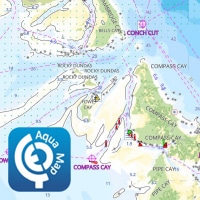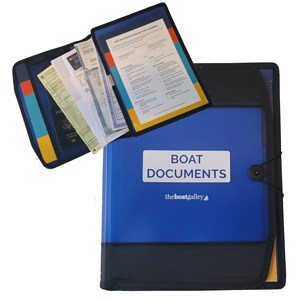Got a smaller boat? Do you drive yourself nuts trying to figure out where to stow the cooler so it’s safe yet easy to access? Here’s an idea that I picked up at a boat show over a year ago. Use the cooler as a step at the base of the companionway.
One advantage to putting the cooler here is that it is low and in the center of the boat. When full of ice, coolers are surprisingly heavy and can affect the trim of the boat. Heavy items are always best kept low and centered. In addition:
- Get a sturdy cooler that is sized correctly for the available space. One with a latching lid is best, both for keeping the cool inside and so that it won’t accidentally open in rough water (think beating to weather with winds 20+) or in the event of a knockdown.
- The wood glued to the top of the cooler both provides good tread and spreads the weight of a person stepping on it over a larger area. I think that this would considerably lengthen the life of the cooler.
- This boat has been designed with the idea that the cooler would form the lower step — if it weren’t there, it’d be a big step down! For boats that have a bottom step, it’s good if the cooler top is at the same level as the step so there isn’t a tripping hazard. You can vary the height of the wood on top of the cooler or add an extra piece to the step to ensure that they line up.
- Engineer some way to secure the cooler in place. You don’t want it to move as someone is stepping on it, nor do you want it to slide into someone who is standing nearby. And something as heavy as a cooler could be seriously dangerous if it went flying in a knockdown.
Okay, I know. In the photo, the cooler only has a bungee around the handle to hold it in place. I just don’t think that’s sufficient for real world conditions.
Further, I’d be wary of many of the pre-packaged “cooler tie down” systems that you can buy. The ones I’ve seen:
- Use screws with no backing plates — there have been numerous reports of them ripping out in rough water.
- The brackets tend to be of a “universal” fit and there is some play in how the base fits into them. This can be a real problem if the step shifts slightly with the motion of the boat as someone is stepping onto it.
- Many use bungee cords to “secure” the cooler. No way is this going to hold in rough water or in the event of a knockdown. Better systems use nylon webbing with some mechanical tightening mechanism (typically rachets).
At the very least, if you choose to use one of these kits, replace the screws with bolts (use lock nuts, lock washers or Lock-Tite) and backing plates or fender washers and choose one with webbing over bungee cords.
Over the years, Dave and I came to make most tie downs ourselves instead of trying to buy something. That way, we could use materials that were best suited to the application (stainless steel bolts, fender washers or backing plates, webbing or low stretch line, etc.). In our first few years of cruising, we tried using a number of packaged solutions for various things and slowly came to the realization that most were designed for fishing boats on protected waters, not for sailboats that heeled or powerboats on more open water. Similarly, items designed for RVs are not suitable as they don’t experience nearly the motion that a boat does.

Carolyn Shearlock has lived aboard full-time for 17 years, splitting her time between a Tayana 37 monohull and a Gemini 105 catamaran. She’s cruised over 14,000 miles, from Pacific Mexico and Central America to Florida and the Bahamas, gaining firsthand experience with the joys and challenges of life on the water.
Through The Boat Galley, Carolyn has helped thousands of people explore, prepare for, and enjoy life afloat. She shares her expertise as an instructor at Cruisers University, in leading boating publications, and through her bestselling book, The Boat Galley Cookbook. She is passionate about helping others embark on their liveaboard journey—making life on the water simpler, safer, and more enjoyable.
Here’s your “Quick Start” to everything you need to know when living on a boat:










The Boat Galley says
For some reason, FB refuses to post the photo of the cooler 🙁
Allan Cobb says
I did whitewater rafting 25 or 30 years ago. We put wood on the tops of our coolers to make the better seats both while rafting and at camp. I typically use 1/4 inch plywood that I varnished. For use as a step, I would use 1/2 inch plywood or solid wood. I used a good contact cement to stick the wood to the cooler and the cooler top. Varnishing the wood will make it last longer (unless you used teak which would be expensive). For use as a step, I would recommend adding rough tread tape to make it slip proof.
The Boat Galley says
Thanks for more how-to!
Maryanne Grady says
Need to show my husband this!
Kathy Belanger-Barber says
My merit 25 came standard with this feature
C David Wrestler says
Looks like a J/24 “step”
Patricia L. McMullen says
The Freedom 21s also came with a cooler step.
Jennifer says
Carolyn, where do you put the wastebasket on your Gemini? Mine is in the locker on the port side where the center board is. I keep cleaning products in there, too, since I don’t want food in the same locker as trash. It’s inconvenient when I’m cooking, though. I hang a plastic grocery bag on the center board bolt on the starboard side when cooking, but it tends to fall off and make a mess.
I love my Gemini. It’s so roomy and I enjoy flat sailing. We’re putting ours away for the winter, just as you’re getting yours out of storage. I hope you enjoy your sailing season as much as I enjoyed mine this year.
Jennifer
Never Leaner
Lake Erie
Carolyn Shearlock says
Right now it doesn’t have a home — still trying to figure that one out. As we’re in the yard, we have trash bags hanging in about six different places! Sorry I don’t have a better answer right now. I’m *kind of* thinking I’ll put one in the starboaard aft cabin for galley use.
C David Wrestler says
Just remembered, one trick the J/24 step/cooler liked to do was to roll forward if you stepped too close to the edge. Some sort of containment is probably needed for safety.
Dave Skolnick (S/V Auspicious) says
A little off topic: I’ve been through a number of coolers of the years. I got an Igloo on sale at a good price. Over the next few years I spent hundreds of dollars on hinges, latches, handles, and tie-downs. Ultimately the case of the cooler failed, apparently due to UV deterioration. Comparing my old Igloo to other common brands like Coleman and various house brands it became clear that coolers aboard, especially those kept in the cockpit or on deck, have a limited life. We grit our teeth and bought a Yeti cooler. After about six years in the cockpit and on the aft deck we have had no parts replacements at all and the only maintenance has been a little Armor-All on the rubber latches.
I have no relationship with either Yeti or Armor-All other than as a happy customer.
Bob Dryer says
Ice will eventually melt. Easily removing the water from the cooler is a problem I haven’t solved. Help.
Carolyn Shearlock says
Larger coolers usually have a drain built in. I just put the cooler so the drain is over the sink and open the drain. If a cooler doesn’t have a drain, I use racks and bins to hold the food over the ice rather than in it, so I remove the food bins, then pour the water out, keeping the lid just cracked so that I don’t lose any ice that remains. Of course, if it’s all water, I just dump it!
Kiyomi Camp says
Our Menger 19 came with this feature. The back half of the cooler slides under the cockpit and the front half has the wood tread. It works great.
Vicki Telesford says
Good thought. David Telesford what do you reckon?
Donna Lynn Tourt Cantwell says
Karen Coyle Butcher
Karen Coyle Butcher says
Can also double as a cutting board/domino table/cards against humanity table